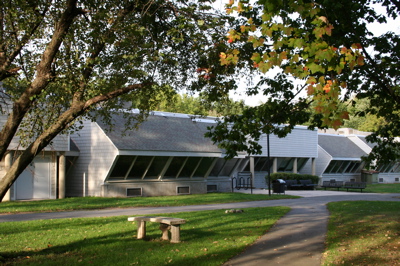More troubled small colleges
Emily Dickinson Hall at Hampshire College. The building was designed by the architecture firm of former faculty member Norton Juster, and and houses much of the space devoted to humanities at the college, including creative writing and theater. It’s named after the famed 19th Century poet, who lived in Amherst.
Adapted from Robert Whitcomb’s “Digital Diary,’’ in GoLocal24.com
A couple of minor private Massachusetts colleges have announced in the past year that they’re folding -- Mount Ida and Newbury colleges. And Green Mountain College, in Vermont, announced last week that’s closing. Small colleges have been closing around America at an accelerating rate but few of them have been particularly distinguished.
However, as the demographic and financial crisis of higher education mounts, some prestigious colleges must close, too, or merge with larger, nearby institutions. Still, it was a bit of a bombshell last Tuesday to learn that Hampshire College, in Amherst, Mass., is in serious enough trouble that it’s seeking a partner, and, I assume, might have to close if it doesn’t get one.
Will a nearby institution rescue Hampshire? If so, it will probably be one of the four that helped found Hampshire in 1965 (it opened for students in 1970} for experimentation in the liberal arts when the Baby Boomer population meant surging applications. Those are the University of Massachusetts at Amherst and Smith, Amherst and Mount Holyoke colleges. Hampshire and the four comprise the Five College Consortium, whose students can take course at any of the schools.
Hampshire is known for its alternative curriculum, emphasis on portfolios rather than course-distribution requirements and reliance on professors’ narrative assessments instead of grade point averages. Despite this seemingly touchy-feely approach, the college sends a big percentage of its graduates off to highly selective graduate schools.
Since 1970, Hampshire (sometimes affectionally called “Hamster’’) has become a sort of semi-elite institution. But its $52 million endowment is far too small for its ambitions and its applications have generally been slipping in recent years as they have at many other private colleges.
Hampshire, unlike some other economically challenged colleges, has not tried to turn itself into a glorified vocational school. Rather it has stuck with an emphasis on the liberal arts – an education that produces the most engaged and effective citizens. So I hope that some way may be found for Hampshire to survive with maximum independence and not just as a sort of experimental-education campus of one or more of the other four institutions in the Five College Consortium.
Hampshire College is in foreground, the University of Massachusetts at Amherst is in the upper left while Amherst College is in upper right. They comprise, with Smith and Mount Holyoke colleges, the Five College Consortium.
— Photo by MonsieurNapoleon

